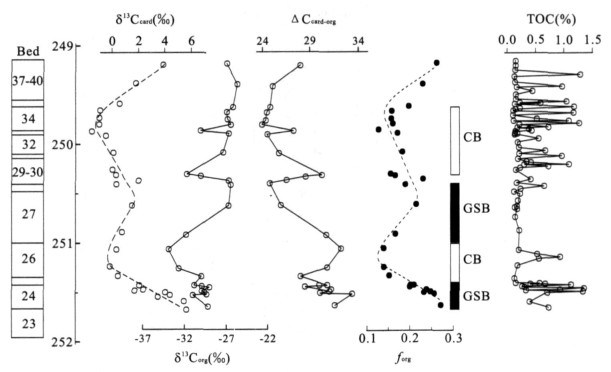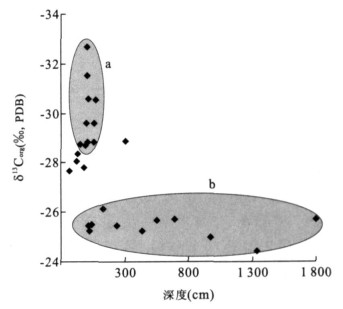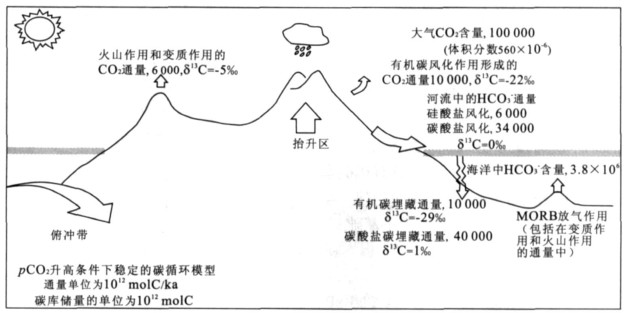The Organic Fraction of the Total Carbon Burial Flux Deduced from Carbon Isotopes across the Permo-Triassic Boundary at Meishan, Zhejiang Province
-
摘要: 根据碳酸盐碳同位素和有机(干酪根) 碳同位素记录, 结合碳循环模式, 计算得到了浙江煤山全球二叠系-三叠系界线层型剖面第23-40层的有机碳埋藏分数forg.在第23-24层和第27-29层下部出现forg的两个高峰值, 与绿硫细菌反映的两个缺氧环境条件相对应.在第25-26层和第32-34层出现两个forg低谷值, 与2-甲基藿烷指示的两次蓝细菌繁盛(第26层和第29层上部到第34层) 基本吻合.这些结果反映了forg与埋藏时的氧化还原条件密切相关.forg与总有机碳含量TOC的关系比较复杂, 一些TOC较高的层位(如第26层) forg却较低, 而一些TOC较低的层位(如第27层) forg却较高, 反映了原始生产力对TOC的重要贡献.根据原始生产力和forg得到的原始有机埋藏量, 可以校正现今测得的残余TOC.本次研究结果说明, 同步有机-无机碳同位素分析, 在建立一定碳循环模型的基础上, 计算有机碳埋藏分数, 可有效指示有机质埋藏状态, 进而为建立生物-环境-有机碳埋藏的耦合关系模型提供基础.Abstract: By combining the carbon cycle model with the records of carbonate and organic (kerogen) carbon isotope composition, this paper presents the calculation of the fraction of organic carbon burial (forg) of beds 23-40 at the GSSP of the Permian-Triassic boundary at Meishan, Zhejiang Province. The resulting calculation produces two episodes of forg maxima observed to occur at beds 23-24 and 27-29, which respectively corresponds to the two episodic anoxic events indicated by the flourish of green sulfur bacteria. Two episodic forg minima occurred at beds 25-26 and 32-34, generally coincident with the flourish of cyanobacteria (bed 26 and upper part of beds 29 to 34) as shown by the high value of 2-melthyhopanes. It appears that the forg is related to the redox conditions, with greater forg values observed at the reductive condition. The relationship between forg and the total organic carbon (TOC) content was complex. The forg value was low at some beds with high TOC content (such as bed 26), whilst high forg values observed at some beds with low TOC content (e. g. bed 27). This association infers the important contribution of primary productivity to the TOC content. The original organic burial could be thus calculated through the configuration of the function of the primary productivity and forg, which can be used to correct the residual TOC measured in modern time. This investigation indicates that compiling the organic-inorganic carbon isotopes with the carbon cycle model favors to understand the fraction of organic carbon burial, providing information for the reconstruction of the coupling among biota, environments and organic burial.
-
Key words:
- carbon isotope /
- carbon cycle /
- organic burial /
- Permian-Triassic boundary
-
图 1 煤山B剖面δ13Corg、δ13Ccarb、forg及TOC随时间变化曲线(年代据Bowring et al., 1998)
CB.蓝细菌繁盛; GSB.绿硫细菌繁盛
Fig. 1. The variation trends of δ13Corg, δ13Ccarb and TOC at Meishan Section B
图 3 Kump and Arthur (1999)提出的碳同位素循环模式
Fig. 3. The carbon cycle model proposed by Kump and Arthur (1999)
表 1 煤山B剖面样品δ13Corg及δ13Ccarb分析结果
Table 1. The δ13Corg and the δ13Ccarb data of the samples analyzed at Meishan section B

表 2 一些层位的有机碳埋藏分数forg、原始生产力P和总有机碳含量TOC
Table 2. The fraction of the organic carbon burial (forg), the primary production (P) and the TOC content in some beds in Meishan section B

-
Bowring, S. A., Erwin, D. H., Jin, Y. G., et al., 1998. U/Pb zircon geochronology and tempo of the end-Permianmass extinction. Science, 280 (5366): 1039-1045. doi: 10.1126/science.280.5366.1039 Cao, C. Q., Wang, W., Jin, Y. G., 2002. Carbon isotope ex-cursions across the Permian-Triassic boundary in the Meishan section, Zhejiang Province, China. Chinese Sci-ence Bulletin, 47 (13): 1125-1129. doi: 10.1360/02tb9252 Dai, J. X., Li, J., Luo, X., et al., 2005. Alkane carbon isotop-ic composition and gas sourcein giant gas field of Ordos basin. Acta Petrolei Sinica, 26 (1): 18-26 (in Chinesewith English abstract). Gao, B., Fan, M., Liu, W. H., et al., 2005. Carbon isotopic features and genetic type of natural gas in Tahe oilfield. Oil & Gas Geology, 26 (5): 618-622 (in Chinese withEnglish abstract). Grice, K., Gao, C., Love, G. D., et al., 2005. Photic zone eu-xinia during the Permian-Triassic superanoxic event. Science, 307: 706-709. doi: 10.1126/science.1104323 Guo, Q. J., Liu, C. Q., Strauss, H., et al., 2004. Isotopic in-vestigation of Late Neoproterozoic and Early Cambrian carbon cycle on the northern Yangtze platform, South China. Acta Geoscientica Sinica, 25 (2): 151-156 (inChinese with English abstract). Haas, J., Demény, A., Hips, K., et al., 2007. Biotic and en-vironmental changes in the Permian-Triassic boundary interval recorded on a western Tethyan ramp in the Bükk Mts., Hungary. Global and Planetary Change, 55 (1-3): 136-154. doi: 10.1016/j.gloplacha.2006.06.010 Hayes, J. M., Strauss, H., Kauf man, A. J., 1999. The abun-dance of 13C in marine organic matter and isotopic frac-tionation in the global biogeochemical cycle of carbon during the past 800 Ma. Chemical Geology, 161 (1-3): 103-125. doi: 10.1016/S0009-2541(99)00083-2 Huang, X. Y., Jiao, D., Lu, L. Q., et al., 2007. The fluctua-ting environment associated with the episodic biotic cri-sis during the Permian-Triassic transition: Evidence from microbial biomarkers in Changxing, Zhejiang Prov-ice. Science in China (Series D), 50: 1052-1059. doi: 10.1007/s11430-007-0024-x Krull, E. S., Lehrmann, D. J., Druke, D., et al., 2004. Stable carbon isotope stratigraphy across the Permian-Triassicboundary in shallow marine carbonate platforms, Nan-panjiang basin, South China. Palaeogeography, Palaeo-climatology, Palaeoecology, 204 (3-4): 297-315. doi: 10.1016/S0031-0182(03)00732-6 Kump, L. R., 1991. Interpreting carbon-isotope excursions: Strangelove oceans. Geology, 19 (4): 299-302. doi: 10.1130/0091-7613(1991)019<0299:ICIESO>2.3.CO;2 Kump, L. R., Arthur, M. A., 1999. Interpreting carbon-iso-tope excursions: Carbonates and organic matter. Chemi-cal Geology, 161 (1-3): 181-198. doi: 10.1016/S0009-2541(99)00086-8 Kump, L. P., Garrels, R. M., 1986. Modeling at mospheric O2 in the global sedimentary redor cycle. Am. J. Sci. , 286: 337-360. doi: 10.2475/ajs.286.5.337 Li, Y. C., Zhou, Z. Z., 2002. Massive dissociation of gas hy-drate during oceanic anoxia as a cause of mass extinc-tion at the end Permian. Geology Geochemistry, 30: 57-63 (in Chinese with English abstract). Magaritz, M., Baer, R., Baud, A., et al., 1988. The carbon-iso-tope shift at the Permian/Triassic boundary in the southern Alps is gradual. Nature, 331 (6154): 337-339. doi: 10.1038/331337a0 Magaritz, M., Krishnamurthy, R. V., Holser, W. T., 1992. Parallel trends in organic and inorganic carbon isotopes across the Permian/Triassic boundary. American Jour-nal of Science, 292 (10): 727-739. doi: 10.2475/ajs.292.10.727 McCrea, J. M., 1950. The isotopic chemistry of carbonates and a paleotemperature scale. The Journal of Chemical Physics, 18: 849-857. doi: 10.1063/1.1747785 Payne, J. L., Lehrmann, D. J., Wei, J. Y., et al., 2004. Large perturbations of the carbon cycle during recovery from the end-Permian extinction. Science, 305 (5683): 506-509. doi: 10.1126/science.1097023 Riccardi, A., Kump, L. R., Arthur, M. A., et al., 2007. Car-bon isotopic evidence for chemocline upward excursions during the end-Permian event. Palaeogeography, Palaeoclimatology, Palaeoecology, 248 (1-2): 73-81. doi: 10.1016/j.palaeo.2006.11.010 Shi, Y. Z., Hu, C. Y., Fang, N. Q., et al., 2004. Carbon iso-topic composition of organic matter in Co-rich ferro-manganese crust and its implication for paleoceanogra-phy. Earth Science—Journal of China University of Geosciences, 29 (2): 148-150 (in Chinese with Englishabstract). Smith, R. M. H., MacLeod, K. G., 1994. Sedimentology and carbonisotope stratigraphy across the Permian-Triassic boundary in the Karoo basin, South Africa. Journal of African Earth Sciences, 27: 185-186. Tenger, Liu, W. H., Xu, Y. C., et al., 2004. Organic carbonisotope record in marine sediment andits environmental significance—An example from Ordos basin, NW Chi-na. Petroleum Exploration and Development, 31 (5): 11-16 (in Chinese with English abstract). Tenger, Liu, W. H., Xu, Y. C., et al., 2006. Comprehensive geochemical identification of highly evolved marine car-bonate rocks as hydrocarbon-source rocks as exempli-fied by the Ordos basin. Science in China (Series D), 49 (4): 384-396. doi: 10.1007/s11430-006-0384-7 Voigt, S., Andrew, S. G., Voigt, T., 2006. Sea-level change, car-bon cycling and palaeocli mate during the Late Cenomanian of northwest Europe: An integrated palaeoenvironmental analysis. Cretaceous Research, 27 (6): 836-858. doi: 10.1016/j.cretres.2006.04.005 Wang, C. J., Liu, Y. M., Liu, H. X., et al., 2005. Geochemi-cal significance of the relative enrichment of Pristaneand the negative excursion of δ13CPr across the Permian-Triassic Boundary at Meishan, China. Chinese Science Bulletin, 50 (19): 2213-2225. doi: 10.1007/BF03182673 Xie, S. C., Pancost, R. D., Huang, J. H., et al., 2007a. Adouble carbon isotope perturbation during the Permo/Triassic crisis. Geology, in press. Xie, S. C., Pancost, R. D., Huang, X. Y., et al., 2007b. Mo-lecular and isotopic evidence for episodic environmental change across the Permo/Triassic boundary at Meishanin South China. Global and Planetary Change, 55 (1-3): 56-65. doi: 10.1016/j.gloplacha.2006.06.016 Xie, S. C., Pancost, R., Yin, H. F., et al., 2005. Two epi-sodes of microbial change coupled with Permo/Triassicfaunal mass extinction. Nature, 434 (7032): 494-497. doi: 10.1038/nature03396 Xu, D. Y., Yan, Z., 1993. Carbon isotope and iridium eventmarkers near the Permian/Triassic boundary in the Meishan section, Zhejiang Province, China. Paleogeogra-phy, Paleoclimatology, Paleoecology, 104 (1-4): 171-175. doi: 10.1016/0031-0182(93)90128-6 Xu, R., Gong, Y. M., Tang, Z. D., 2006. Blooming ofbacteria and algae: Possible killer of Devonian Frasnian-Famennian mass extinction? Earth Science—Journal of China University of Geosciences, 31 (6): 787-797 (inChinese with English abstract). Xu, Y. C., Shen, P., Liu, W. H., et al., 2001. Isotopic composi-tion characteristics and identification of immature and low-mature oils. Chinese Science Bulletin, 46 (22): 1923-1929. doi: 10.1007/BF02901173 Yin, H. F., Zhang, K. X., Tong, J. N., et al., 2001. The Global Stratotype Section and Point (GSSP) of the Per-mian-Triassic boundary. Episodes, 24 (2): 102-114. doi: 10.18814/epiiugs/2001/v24i2/004 Zhang, F., Feng, Q. L., He, W. H., et al., 2006. Multidisci-plinary stratigraphy across the Permian-Triassic bound-ary in deep-water environment of the Dongpan section, South China. Norwegian Journal of Geology, 125-131. Zhang, S. C., Wang, R. L., Jin, Z. J., et al., 2006. The rela-tionship between the Cambrian-Ordovician high-TOC source rock development and paleoenvironment varia-tions in the Tarim basin, Western China: Carbon and oxygen isotope evidence. Acta Geologica Sinica, 80 (3): 459-466 (in Chinese with English abstract). 戴金星, 李剑, 罗霞, 等, 2005. 鄂尔多斯盆地大气田的烷烃气碳同位素组成特征及其气源对比. 石油学报, 26 (1): 18-26. https://www.cnki.com.cn/Article/CJFDTOTAL-SYXB200501003.htm 高波, 范明, 刘文汇, 等, 2005. 塔河油田天然气的碳同位素特征及其成因类型. 石油与天然气地质, 26 (5): 618-622. doi: 10.3321/j.issn:0253-9985.2005.05.010 郭庆军, 刘丛强, Strauss, H., 等, 2004. 晚震旦世至早寒武世扬子地台北缘碳同位素研究. 地球学报, 25 (2): 151-156. doi: 10.3321/j.issn:1006-3021.2004.02.010 李玉成, 周忠泽, 2002. 华南二叠纪末缺氧海水中的有毒气体与生物绝灭事件. 地质地球化学, 30: 57-63. https://www.cnki.com.cn/Article/CJFDTOTAL-DZDQ200201009.htm 史跃中, 胡超涌, 方念乔, 等, 2004. 富钴结壳中有机碳同位素组成特征及其古海洋意义. 地球科学——中国地质大学学报, 29 (2): 148-150. https://www.cnki.com.cn/Article/CJFDTOTAL-DQKX200402004.htm 腾格尔, 刘文汇, 徐永昌, 等, 2004. 海相沉积有机质的碳同位素记录及其环境意义——以鄂尔多斯盆地为例. 石油勘探与开发, 31 (5): 11-16. doi: 10.3321/j.issn:1000-0747.2004.05.003 徐冉, 龚一鸣, 汤中道, 2006. 菌藻类繁盛: 晚泥盆世大灭绝的疑凶?地球科学——中国地质大学学报, 31 (6): 787-797. https://www.cnki.com.cn/Article/CJFDTOTAL-DQKX200606006.htm 张水昌, Wang, R. L., 金之钧, 等, 2006. 塔里木盆地寒武纪-奥陶纪优质烃源岩沉积与古环境变化的关系: 碳氧同位素新证据. 地质学报, 80 (3): 459-466. doi: 10.3321/j.issn:0001-5717.2006.03.020 -










 下载:
下载:



